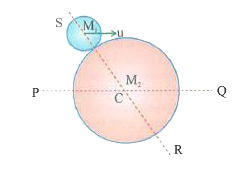A particle of mass m moving with speed u collides perfectly inelastically with another particle of mass 2m at rest. Find loss of kinetic energy of system in the collision.
To solve the problem of finding the loss of kinetic energy during a perfectly inelastic collision between two particles, we can follow these steps:
Step 1: Determine the initial kinetic energy of the system
The initial kinetic energy (KE_initial) of the system is only due to the moving particle of mass m with speed u. The particle of mass 2m is at rest, so its kinetic energy is zero.
KEinitial=12mu2+0=12mu2
Step 2: Determine the final velocity after the collision
In a perfectly inelastic collision, the two particles stick together after colliding. We can use the conservation of momentum to find their final velocity.
The initial momentum of the system is given by:
pinitial=m⋅u+2m⋅0=mu
Let Vf be the final velocity of the combined mass after the collision. The total mass after the collision is m+2m=3m. According to the conservation of momentum:
mu=(3m)Vf
Solving for Vf:
Vf=mu3m=u3
Step 3: Calculate the final kinetic energy of the system
Now we can calculate the final kinetic energy (KE_final) of the combined mass after the collision.
KEfinal=12⋅(3m)⋅V2f=12⋅(3m)⋅(u3)2
Calculating V2f:
V2f=(u3)2=u29
Now substituting this back into the equation for KEfinal:
KEfinal=12⋅(3m)⋅u29=3mu218=mu26
Step 4: Calculate the loss of kinetic energy
The loss of kinetic energy (ΔKE) during the collision can be found by subtracting the final kinetic energy from the initial kinetic energy:
ΔKE=KEinitial−KEfinal=12mu2−mu26
To perform this subtraction, we need a common denominator:
ΔKE=36mu2−16mu2=26mu2=13mu2
Final Answer
The loss of kinetic energy of the system in the collision is:
ΔKE=13mu2
---
The initial kinetic energy (KE_initial) of the system is only due to the moving particle of mass m with speed u. The particle of mass 2m is at rest, so its kinetic energy is zero.
In a perfectly inelastic collision, the two particles stick together after colliding. We can use the conservation of momentum to find their final velocity.
Now we can calculate the final kinetic energy (KE_final) of the combined mass after the collision.
The loss of kinetic energy (ΔKE) during the collision can be found by subtracting the final kinetic energy from the initial kinetic energy:
The loss of kinetic energy of the system in the collision is:
Topper's Solved these Questions
- BOOK - DC PANDEYCHAPTER - CENTRE OF MASSEXERCISE - Check points50videos
CENTRE OF MASS
- BOOK - DC PANDEYCHAPTER - CENTRE OF MASSEXERCISE - Taking it together73videos
CENTRE OF MASS
- BOOK - DC PANDEYCHAPTER - CALORIMETRY AND HEAT TRANSFEREXERCISE - Medical entrance s gallery38videos
CALORIMETRY AND HEAT TRANSFER
- BOOK - DC PANDEYCHAPTER - CENTRE OF MASS, IMPULSE AND MOMENTUMEXERCISE - Comprehension type questions15videos
CENTRE OF MASS, IMPULSE AND MOMENTUM
Similar Questions
A particle of mass 2kg moving with speed 4ms, collides perfect inelastically with another particle of mass 4kg at rest.The loss of kinetic energy of system in the collision is A.325J B.163J C. 165J D. 323J
View SolutionA moving particle of mass m makes a head-on perfectly inelastic collision with a particle of mas 2m which is initially at rest. Find the fractional loss in energy of the colliding partic le after collision.
View Solution
Knowledge Check
- Question 1 - Select One
A particle of mass m moving with speed u collides perfectly inelastically with another particle of mass 3 m at rest. Loss of KE of system in the collision is
A34μ2B38μ2C14μ2D18μ2 - Question 2 - Select One
A particle of mass m moving with speed V collides eleastically with another particle of mass 2mFind speed of smaller mass after head on collision
Av3B−v3C2v3D−2v3 - Question 3 - Select One
A ball of mass M moving with speed v collides perfectly inelastically with another ball of mass m at rest. The magnitude of impulse imparted to the first ball is
AMvBmvCMmM+mvDM2M+mv
A particle of mass m moving with velocity u collides elastically head on with a particle of mass 2m at rest. After collision the heavier particle moves with velocity?
View SolutionA particle of mass m moving with speed v in position x - direction collides perfectly inelastically with another identical particle moving with same speed in positive y - direction . Find final velocity of the combination.
View SolutionA particle of mass 100 g moving ast an initial speed u collides with another particle of same mass kept initially at rest. If the totl kinetic energy becomes 0.2 J after the collision wht could be minimum and the maximum value of u.
View SolutionA ball of mass M moving with a velocity v collides perfectly inelastically with another ball of same mass but moving with a velocity v in the opposite direction. After collision
View SolutionAn object of mass M1 moving horizontally with speed u collides elastically with another object of mass M2 at rest. Select correct statement.
 View Solution
View Solution

